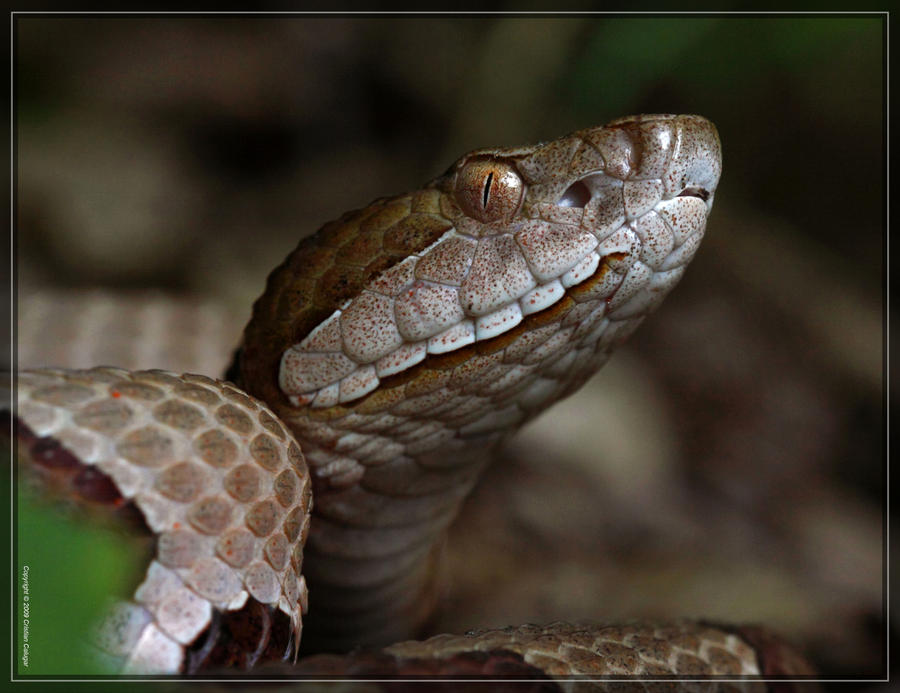ShopDreamUp AI ArtDreamUp
Deviation Actions
Description
Copperhead (Agkistrodon contortrix)
The Copperhead is a venomous pit viper species found in North America. Five subspecies are currently recognized. Common names: copperhead, chunk head, death adder, highland moccasin.
Adults usually grow to a total length of 50 - 150 cm (20 - 37 in), although some may exceed 1 m (3.3 ft). Males are usually larger than females. The maximum length reported for this species is 134.6 cm (53.0 in). The body is relatively stout and the head is broad and distinct from the neck. Because the snout slopes down and back, it appears less blunt than that of the cottonmouth, A. piscivorus. Consequently, the top of the head extends further forward than the mouth.
Found in the United States in the states of Texas, Oklahoma, Kansas, Missouri, Arkansas, Louisiana, Mississippi, Alabama, Georgia, Florida, South Carolina, North Carolina, Tennessee, Kentucky, Virginia, West Virginia, Illinois, Indiana, Ohio, Iowa, Pennsylvania, Maryland, New Jersey, Delaware, New York, Connecticut and Massachusetts. In Mexico it occurs in Chihuahua and Coahuila. The type locality is "Carolina."
Within its range it occupies a variety of different habitats. In most of North America it favors deciduous forest and mixed woodlands. It is often associated with rock outcroppings and ledges, but is also found in low-lying swampy regions.
Roughly 90% of its diet consists of small rodents, such as mice and voles. They have also shown fondness for large insects and frogs, and though highly terrestrial, have been known to climb trees to gorge on emerging cicadas.
Although venomous, these snakes are generally non-aggressive and bites are almost never fatal. Copperhead venom has an estimated lethal dose of around 100 mg, and tests on mice show its potency is among the lowest of all pit vipers, and slightly weaker than that of its close relative, the cottonmouth. Copperheads often employ a "warning bite" when stepped on or agitated and inject a relatively small amount of venom, if any at all. "Dry bites" involving no venom are particularly common with the copperhead, though all pit vipers are capable of a dry bite. Bite symptoms include intense pain, tingling, throbbing, swelling, and severe nausea. The very few reported deaths from copperhead bites all involved multiple snakes.
The venom of the Southern copperhead has been found to hold a protein called "Contortrostatin" that halts the growth of cancer cells and also stops the migration of the tumors to other sites. It will probably be ten or more years before contortrostatin is used in practical treatment but it has shown to be a novel anti-cancer drug in the lab.
More info: [link]
Submitted to the Wild at Heart contest , held by =Ultra-Violet-X .
The Copperhead is a venomous pit viper species found in North America. Five subspecies are currently recognized. Common names: copperhead, chunk head, death adder, highland moccasin.
Adults usually grow to a total length of 50 - 150 cm (20 - 37 in), although some may exceed 1 m (3.3 ft). Males are usually larger than females. The maximum length reported for this species is 134.6 cm (53.0 in). The body is relatively stout and the head is broad and distinct from the neck. Because the snout slopes down and back, it appears less blunt than that of the cottonmouth, A. piscivorus. Consequently, the top of the head extends further forward than the mouth.
Found in the United States in the states of Texas, Oklahoma, Kansas, Missouri, Arkansas, Louisiana, Mississippi, Alabama, Georgia, Florida, South Carolina, North Carolina, Tennessee, Kentucky, Virginia, West Virginia, Illinois, Indiana, Ohio, Iowa, Pennsylvania, Maryland, New Jersey, Delaware, New York, Connecticut and Massachusetts. In Mexico it occurs in Chihuahua and Coahuila. The type locality is "Carolina."
Within its range it occupies a variety of different habitats. In most of North America it favors deciduous forest and mixed woodlands. It is often associated with rock outcroppings and ledges, but is also found in low-lying swampy regions.
Roughly 90% of its diet consists of small rodents, such as mice and voles. They have also shown fondness for large insects and frogs, and though highly terrestrial, have been known to climb trees to gorge on emerging cicadas.
Although venomous, these snakes are generally non-aggressive and bites are almost never fatal. Copperhead venom has an estimated lethal dose of around 100 mg, and tests on mice show its potency is among the lowest of all pit vipers, and slightly weaker than that of its close relative, the cottonmouth. Copperheads often employ a "warning bite" when stepped on or agitated and inject a relatively small amount of venom, if any at all. "Dry bites" involving no venom are particularly common with the copperhead, though all pit vipers are capable of a dry bite. Bite symptoms include intense pain, tingling, throbbing, swelling, and severe nausea. The very few reported deaths from copperhead bites all involved multiple snakes.
The venom of the Southern copperhead has been found to hold a protein called "Contortrostatin" that halts the growth of cancer cells and also stops the migration of the tumors to other sites. It will probably be ten or more years before contortrostatin is used in practical treatment but it has shown to be a novel anti-cancer drug in the lab.
More info: [link]
Submitted to the Wild at Heart contest , held by =Ultra-Violet-X .
Image size
3939x3030px 3 MB
Make
Canon
Model
Canon EOS 50D
Shutter Speed
1/197 second
Aperture
F/8.0
Focal Length
100 mm
ISO Speed
500
Date Taken
Jul 12, 2009, 10:29:36 AM
© 2009 - 2024 Cristian-M
Comments39
Join the community to add your comment. Already a deviant? Log In
I got one of those dry bites once in the foot.


































